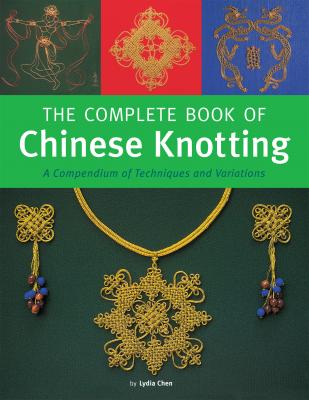ТОП просматриваемых книг сайта:
The Complete Book of Chinese Knotting. Lydia Chen
Читать онлайн.Название The Complete Book of Chinese Knotting
Год выпуска 0
isbn 9781462916450
Автор произведения Lydia Chen
Жанр Сделай Сам
Издательство Ingram
Published by Tuttle Publishing, an imprint of Periplus Editions (HK) Ltd, with editorial offices at 354 Innovation Drive, North Clarendon, Vermont 05759, USA, and 61 Tai Seng Avenue #02-12, Singapore 534167.
Text and illustrations copyright © 1997 Echo Publishing Company Limited and Lydia Chen First Tuttle edition 2007
All rights reserved. No part of this publication may be reproduced or utilized in any form or by any means, electronic or mechanical, including photocopying, recording, or by any information storage and retrieval system, without prior written permission of the publisher.
Library of Congress Control Number
2007920603
ISBN: 978 0 8048 3679 1
ISBN: 978-1-4629-1645-0 (ebook)
Distributed by
North America, Latin America and Europe
Tuttle Publishing
364 Innovation Drive
North Clarendon, VT 05759, USA
Tel: 1 (802) 773 8930
Fax: 1 (802) 773 6993
[email protected] www.tuttlepublishing.com
Japan
Tuttle Publishing
Yaekari Building, 3rd Floor
5-4-12 Osaki, Shinagawa-ku
Tokyo 141-0032
Tel: (81) 3 5437 0171
Fax: (81) 3 5437 0755
Asia Pacific
Berkeley Books Pte Ltd
61 Tai Seng Avenue #02-12
Singapore 534167
Tel: (65) 6280 1330
Fax: (65) 6280 6290
[email protected] www.periplus.com
First edition
10 09 08 10 9 8 7 6 5 4 3 2
Printed in Hong Kong
TUTTLE PUBLISHING® is a registered trademark of Tuttle Publishing, a division of Periplus Editions (HK) Ltd.
Contents
Chinese Knots in Ancient Times
Special Characteristics of Chinese Knots
Chinese Knotting Techniques
FOUR MAIN METHODS OF TYING BASIC KNOTS
NINE WAYS OF MODIFYING BASIC KNOTS
EXTENSIONS AND VARIATIONS OF BASIC KNOTS
Cloverleaf Knot
Pan Chang Knot
Round Brocade knot
Constellation Knot
Good Luck Knot
Buddha Knot
Double Connection Knot
Plafond Knot
Double Coin Knot
Button Knot
Creative Chinese Knotting Designs
CONCEIVING A DESIGN
Real and Imaginary Creatures
Flowers and People
Painting Chinese Knots
Plafond Designs
Jewelry and Ornaments
Born first out of practical necessity in ancient times, Chinese knots were soon employed as decorative motifs on artifacts, both functional and ornamental. Between the Warring States Period, when the prototype of the double coin knot evolved, to the Qing Dynasty, to which the plafond knot has been dated, there is ample archaeological evidence that twelve basic knots were developed by Chinese master craftsmen over the centuries before the modern era.
WARRING STATES PERIOD (475–221 BCE)
Prototype vertical double coin knots on a pedestal box from Zhao Qing’s tomb, Taiyuan, Shanxi Province.
WESTERN HAN PERIOD (206 BCE–CE 8)
Double coin knot
Horizontal double coin knot on a rubbing taken off a stone carving, Western Han Period, from Feng Lu Jiu’s tomb, Tang He, Henan Province.
HAN DYNASTY (206 BCE–CE 220)
Flat knot
Button knot
Flat knot on the top of a jade pendant. Photo courtesy Palace Museum, Taipei.
Button knot on a rubbing taken off a stone carving from an ancient tomb in Shandong Province.
NORTHERN ZHOU PERIOD (CE 557–588)
Good luck knot on a statue of Kuan Yin, the Goddess of Mercy, from cave 55, Maiji Caves, Tianshui, Gansu Province.
Prototype of the good luck knot.
A Unique Handicraft
The Shuowen Jiezi, the first comprehensive Chinese character dictionary, compiled around CE 100, defines the word “knot” as “the joining of two cords.” Knotting is an ancient and highly regarded art form in China and an integral part of Chinese life. Because such knotwork appeared in ancient times, was developed in the Tang and Song dynasties in China and was popularized during the Ming and Qing dynasties, the knots are naturally enough referred to as Chinese knots.

